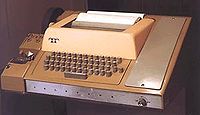Difference between revisions of "Teletype"
(A start...) |
m (Add image) |
||
| (5 intermediate revisions by the same user not shown) | |||
| Line 1: | Line 1: | ||
| − | '''Teletype''' is the name for the mechanical | + | '''Teletype''' is the name for the mechanical [[printing terminal]]s for connection to an [[asynchronous serial line]] produced by the Teletype Corporation. |
| − | + | [[Image:asr33.jpg|200px|right|An ASR33]] | |
| − | The Model 33 came in three different | + | Many different models were produced over the years, but the one most commonly used with computers was the Model 33, which used the [[ASCII]] code (uppercase only), one of the first to do so. |
| + | |||
| + | Although an [[EIA RS-232 serial line interface|EIA]] interface option has reportedly been seen, most used the [[20mA current loop serial line interface|20mA current loop]] interface. | ||
| + | |||
| + | It operated at 10 characters per second, and used a cylindrical typewheel to print. It was initially produced in the mid-60's, but production continued until 1981; its low cost made it a popular choice. | ||
| + | |||
| + | The Model 33 came in three different variants: | ||
* ASR (Automatic Send/Receive) - in addition to the keyboards and printer, it included a [[paper tape]] reader/punch on the side | * ASR (Automatic Send/Receive) - in addition to the keyboards and printer, it included a [[paper tape]] reader/punch on the side | ||
| Line 9: | Line 15: | ||
* RO (Receive Only) - only the printer | * RO (Receive Only) - only the printer | ||
| − | The ASR-33 (formally the "Model 33 ASR") was widely used on early [[minicomputer]]s, | + | The ASR-33 (formally the "Model 33 ASR") was widely used on early [[minicomputer]]s, in part because the paper tape option could be used to load [[binary]] program tapes. |
| + | |||
| + | The later Models 37 (15 cps) and 38 (10 cps) added lower case, a number of special symbols, and a two-colour (red/black) printing ribbon; they too were available in ASR, KSR and RO variants. | ||
| + | |||
| + | ==External links== | ||
| − | + | * [http://homepage.cs.uiowa.edu/~jones/pdp8/UI-8/ks7470oil.shtml About KS7470 oil and KS7471 grease] - Modern equivalents for Teletype lubricants | |
| − | {{stub}} | + | {{semi-stub}} |
| − | [[Category:Terminals]] | + | [[Category:Printing Terminals]] |
Latest revision as of 04:46, 18 December 2018
Teletype is the name for the mechanical printing terminals for connection to an asynchronous serial line produced by the Teletype Corporation.
Many different models were produced over the years, but the one most commonly used with computers was the Model 33, which used the ASCII code (uppercase only), one of the first to do so.
Although an EIA interface option has reportedly been seen, most used the 20mA current loop interface.
It operated at 10 characters per second, and used a cylindrical typewheel to print. It was initially produced in the mid-60's, but production continued until 1981; its low cost made it a popular choice.
The Model 33 came in three different variants:
- ASR (Automatic Send/Receive) - in addition to the keyboards and printer, it included a paper tape reader/punch on the side
- KSR (Keyboard Send/Receive) - as above, but no paper tape reader/punch
- RO (Receive Only) - only the printer
The ASR-33 (formally the "Model 33 ASR") was widely used on early minicomputers, in part because the paper tape option could be used to load binary program tapes.
The later Models 37 (15 cps) and 38 (10 cps) added lower case, a number of special symbols, and a two-colour (red/black) printing ribbon; they too were available in ASR, KSR and RO variants.
External links
- About KS7470 oil and KS7471 grease - Modern equivalents for Teletype lubricants
